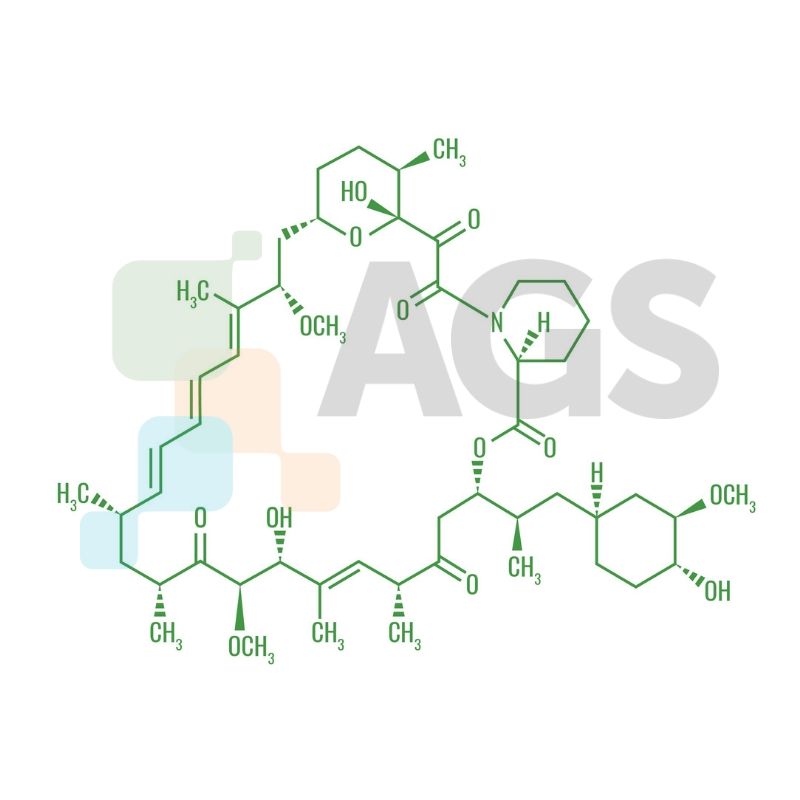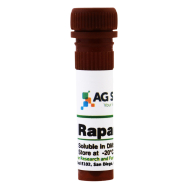Rapamycin is a macrocyclic triene antibiotic that binds to the cytosolic protein FK-binding protein 12 (FKBP12) and inhibits mTOR pathway by directly binding to the mTOR Complex 1 (mTORC1). It is a potent immunosuppressant having a variety of uses both in vitro and in vivo and is used to prevent organ rejection after transplantation.
Discovery of Rapamycin
Rapamycin is a macrocyclic triene antibiotic that binds to the cytosolic protein FK-binding protein 12 (FKBP12) and inhibits mTOR pathway by directly binding to the mTOR Complex 1 (mTORC1). It is a potent immunosuppressant having a variety of uses both in vitro and in vivo and is used to prevent organ rejection after transplantation.
This antibiotic was originally isolated as a fungicide from the soil bacteria, Streptomyces hygroscopicus, collected from Easter Island (known as Rapa Nui to the natives) in the South Pacific in 1975. Structurally similar to the immunosuppressive drug FK-506 (tacrolimus), rapamycin was initially developed to prevent rejection of organs for transplant patients.
What is the commercial name of this compound?
The commercial drug name is Sirolimus. Numerous studies have been performed to demonstrate the anticancer activity of Sirolimus in a wide range of malignancies. Clinical trials of Sirolimus in cancer therapy are currently active. The effects of rapamycin are being evaluated in combination with other drugs.What is the chemical name of Rapamycin?
- Sirolimus
- Rapamune
- Sirolimusum
What is the chemical formula?
What is the physical appearance?
AG Scientific's rapamycin is supplied as a white to off-white powder.
What is the molecular weight?
The molecular weight of this compound is 914.2 g/mol.
What is mTOR?
mTOR is a serine kinase also known as the following:- Mammalian target of rapamycin
- Mechanistic target of rapamycin
- FK-506-binding protein 12-rapamycin-associated-protein 1
- FRAP1
This kinase is encoded by the mTOR gene in humans and plays an important role cellular growth and metabolism control.
mTOR forms two major complexes: mTORC1 and mTORC2
- The mTORC1 consists of mTOR, Raptor, mLST8, FKBP38, PRAS40, and Deptor
- The mTORC2 consists of mTOR, Rictor, Protor, mLST8, mSin1 and Deptor
What is the mTOR signalling pathway?
The mTOR signalling pathway works as a master growth regulator that senses and integrates diverse nutritional and environmental cues, including growth factors, energy levels, cellular stress, and amino acids. It couples these signals to the promotion of cellular growth by phosphorylating substrates that potentiate anabolic processes such as mRNA translation and lipid synthesis, or limit catabolic processes such as autophagy.
The small GTPase Rheb, in its GTP-bound state, is a necessary and potent stimulator of mTORC1 kinase activity, which is negatively regulated by its GAP, the tuberous sclerosis heterodimer TSC1/2. Most upstream inputs are funneled through Akt and TSC1/2 to regulate the nucleotide-loading state of Rheb.
What is the role of MicroRNAs in mTOR Signaling?
MicroRNA (miRNA) is a class of short noncoding RNAs that regulate the expression of a wide variety of genes. Deregulation of miRNAs is a hallmark of cancer. Recent studies have revealed interplays between miRNAs and the mTOR pathway during cancer development. Such interactions appear to provide a fine-tuning of various cellular functions and contribute qualitatively to the behavior of cancer.
What is the structural basis for mTOR function?
The phosphoinositide 3-kinase (PI3K) related protein kinases (PIKKs) are a family of protein kinases with a diverse range of vital cellular functions. Recent high-resolution crystal structures of the protein kinase mTOR suggest general architectural principles that are likely to be common to all of the PIKKs. Furthermore, the structures make clear the close relationship of the PIKKs to the PI3Ks. However, the structures also make clear the unique features of mTOR that enable its substrate specificity.The active site is deeply recessed and flanked by structural elements unique to the PIKKs, namely, the FRB domain, the LST8 binding element, and a C-terminal stretch of helices known as the FATC domain. The FRB has a conserved element in it that is part of a bipartite substrate recognition mechanism that is probably characteristic of all of the PIKKs. The FRB also binds the mTOR inhibitor rapamycin that has been referred to as an allosteric inhibitor, implying that this inhibitor is actually a competitive inhibitor of the protein substrate. This bipartite substrate-binding site also helps clarify how rapamycin can result in substrate-specific inhibition.
How many binding surfaces does Rapamycin have?
This compound has two binding surfaces: one that binds to FKBP12 and the other to the Frb domain of mTOR/FRAP, directing their dimerization. rapamycin is a potent cell growth inhibitor, but chemical modification of the surface contacting Frb alleviates this effect.
What is the mechanism of action of Rapamycin?
Rapamycin is a macrocyclic triene antibiotic that inhibits the highly conserved protein kinase target of rapamycin (TOR) by forming a complex with immunophilin FKBP12 (12 kDa FK506-binding protein; also known as FKBP1A), which then binds directly to mammalian TOR complex 1 (mTORC1) and inhibits mTOR pathway.
For this process, first rapamycin binds with FKBP12 to form an active complex. Through a hydrophobic face of rapamycin, it binds to the FRB domain of mTOR, which is a part of the mTORC1 complex with raptor.
The FRB domain lies outside the catalytic domain of mTOR. Consequently, rapamycin is not a direct inhibitor of mTOR kinase activity. Rapamycin-FKBP12 binds to mTOR and displaces the raptor. As raptor binds substrates (4E-BP1 and S6K1) it is postulated that, displacement by the rapamycin complex prevents accurate presentation of substrates to the kinase domain of mTOR.
Rapamycin-FKBP12 binds to mTOR and displaces the raptor. As raptor binds substrates (4E-BP1 and S6K1) it is postulated that, displacement by the Rapamycin complex prevents accurate presentation of substrates to the kinase domain of mTOR.
mTOR signaling results in the phosphorylation and inactivation of 4E-BP1, the suppressor of eukaryotic initiation factor 4E (eIF4E), a protein that binds the 7mGTPpppN structure (cap) of mRNA. mTOR Phosphorylates and activates ribosomal S6K1. By inhibiting mTOR signalling, rapamycin treatment results in the inhibition of cap-dependent translation that is required for translation of mRNA species.
Explain rapamycin's immunoregulatory functions through mTOR inhibition
The potent immunosuppressive action of rapamycin is commonly ascribed to inhibition of growth factor-induced T cell proliferation. However, it is evident that the serine/threonine protein kinase mammalian target of rapamycin (mTOR) has an important role in the modulation of both innate and adaptive immune responses. mTOR regulates diverse functions of professional antigen-presenting cells, such as dendritic cells (DCs), and has important roles in the activation of effector T cells and the function and proliferation of regulatory T cells.What is the lab application of Rapamycin?
Rapamycin is used in biology research as an agent for chemically induced dimerization. In this application, rapamycin is added to cells expressing two fusion constructs, one of which contains the rapamycin-binding FRB domain from mTOR and the other of which contains an FKBP domain. Each fusion protein also contains additional domains that are brought into proximity when rapamycin induces binding of FRB and FKBP. In this way, rapamycin can be used to control and study protein localization and interactions.
What is the working concentration?
- 10-100 nM when used as an inhibitor in the TLR signaling cascade
- 10-500 nM when used to induce autophagy
What is the stability of Rapamycin?
The compound is stable for 2~3 years at -20°C. To ensure stability of the product in general, storing the product by following the manufacturer’s instructions is preferable for the customers.How should this compound be stored?
Rapamycin is hygroscopic! At the moment of arrival it needs to be stored desiccated at -20℃. Do not forget to protect from light and moisture.What are the analogs of this compound?
The analogs of rapamycin are called Rapalogs. They have the same molecular scaffold but different physicochemical properties. Rapalogs are the first generation of mTOR inhibitors,which inhibit the activity of mTORC1 via binding to FKBP-12 and forming a ternary complex with mTOR. Clinical trials are ongoing with rapamycin, temsirolimus, everolimus and deforolimus in a wide range of human malignancies. Temsirolimus and everolimus have been approved by the FDA for the treatment of patients with advanced renal cell carcinoma. Everolimus has also been approved as monotherapy or a component of combination therapy for pediatric and adult patients with subependymal giant cell astrocytoma (SEGA), progressive neuroendocrine tumors of pancreatic origin (PNET), and SEGA associated with tuberous sclerosis (TS).What is the recent development in Rapamycin research?
Evidence from preclinical studies on several organisms including mice has shown rapamycin to increase lifespan by 60%. Equipped with this evidence rapamycin has entered clinical trials, where it is being studied on middle aged dogs as an anti aging pill. Currently rapamycin is in phase 2 of the trials. At high doses, rapamycin is used successfully in human patients to prevent organ transplant rejection and to fight cancer. At low doses, rapamycin slows aging and extends lifespan in several organisms, including mice, with few or no side effects.Additional Reading
-
Cancer Treatment: Combination of Paclitaxel, Rapamycin, and 17-AAG
-
What Can Be Done to Fight Antibiotic Resistance?
-
Polyene Macrolide Antibiotics
